Comparing Leadership Theories: Transformational and LMX
VerifiedAdded on 2022/11/11
|7
|2245
|291
Essay
AI Summary
This essay provides a comparative analysis of two prominent leadership theories: transformational leadership and leader-member exchange (LMX) theory. It begins by introducing both theories, highlighting their core principles and objectives. Transformational leadership is presented as a model that emphasizes inspiring and motivating team members through vision and ethical conduct, while the LMX theory focuses on the two-way relationships between leaders and individual team members. The essay then delves into a detailed comparison, contrasting the advantages and disadvantages of each theory. Transformational leadership is praised for fostering innovation and change management, while LMX is valued for its relational focus and ease of implementation. The essay also acknowledges potential drawbacks, such as the limitations of transformational leadership in certain contexts and the potential for unfairness in LMX. The essay uses examples, such as Steve Jobs, to illustrate the practical implications of each theory. The conclusion summarizes the key differences and suggests that transformational leadership is more effective overall. The essay is supported by several academic references.

Leadership
Student’s Name:
Student’s ID:
Student’s Name:
Student’s ID:
Paraphrase This Document
Need a fresh take? Get an instant paraphrase of this document with our AI Paraphraser
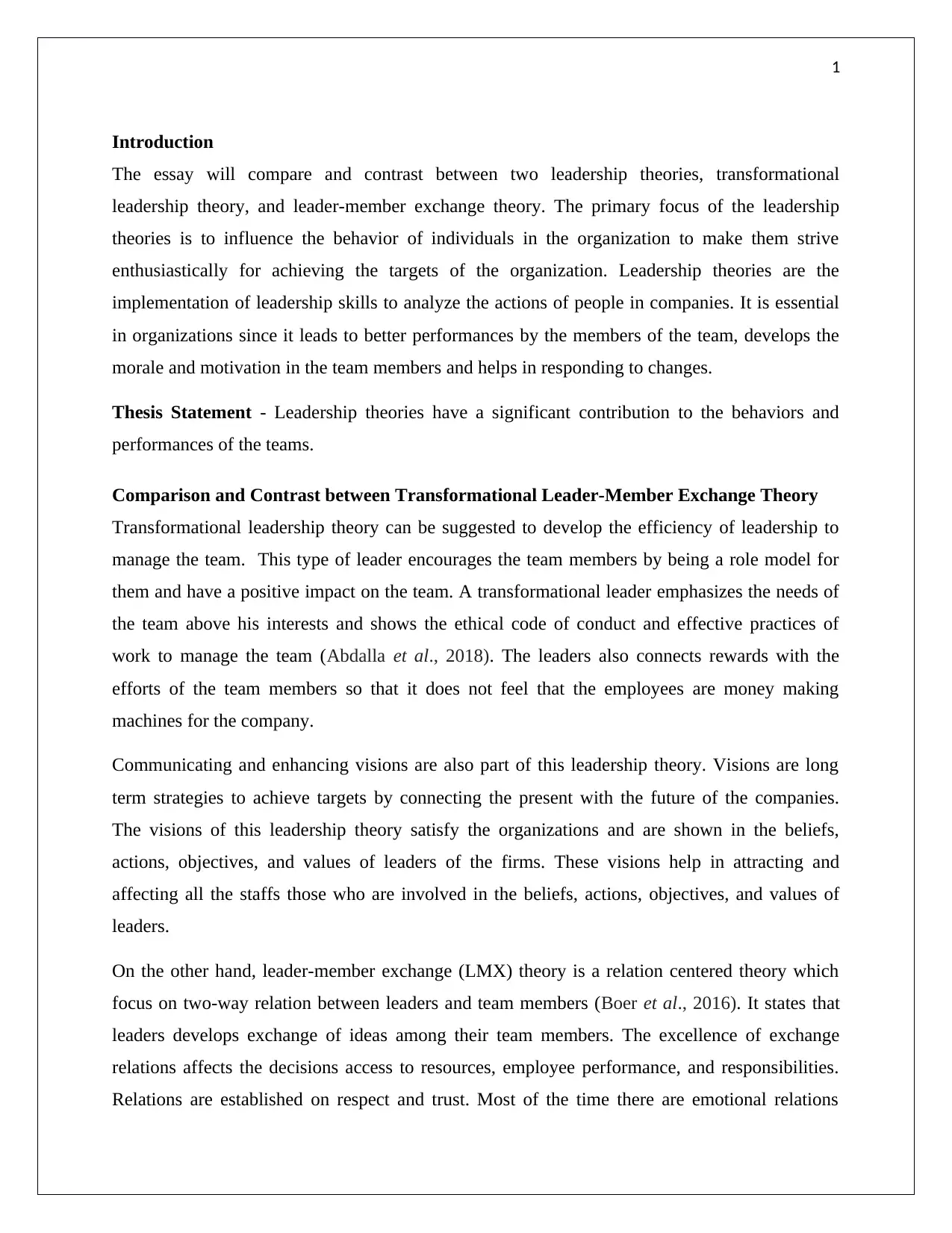
1
Introduction
The essay will compare and contrast between two leadership theories, transformational
leadership theory, and leader-member exchange theory. The primary focus of the leadership
theories is to influence the behavior of individuals in the organization to make them strive
enthusiastically for achieving the targets of the organization. Leadership theories are the
implementation of leadership skills to analyze the actions of people in companies. It is essential
in organizations since it leads to better performances by the members of the team, develops the
morale and motivation in the team members and helps in responding to changes.
Thesis Statement - Leadership theories have a significant contribution to the behaviors and
performances of the teams.
Comparison and Contrast between Transformational Leader-Member Exchange Theory
Transformational leadership theory can be suggested to develop the efficiency of leadership to
manage the team. This type of leader encourages the team members by being a role model for
them and have a positive impact on the team. A transformational leader emphasizes the needs of
the team above his interests and shows the ethical code of conduct and effective practices of
work to manage the team (Abdalla et al., 2018). The leaders also connects rewards with the
efforts of the team members so that it does not feel that the employees are money making
machines for the company.
Communicating and enhancing visions are also part of this leadership theory. Visions are long
term strategies to achieve targets by connecting the present with the future of the companies.
The visions of this leadership theory satisfy the organizations and are shown in the beliefs,
actions, objectives, and values of leaders of the firms. These visions help in attracting and
affecting all the staffs those who are involved in the beliefs, actions, objectives, and values of
leaders.
On the other hand, leader-member exchange (LMX) theory is a relation centered theory which
focus on two-way relation between leaders and team members (Boer et al., 2016). It states that
leaders develops exchange of ideas among their team members. The excellence of exchange
relations affects the decisions access to resources, employee performance, and responsibilities.
Relations are established on respect and trust. Most of the time there are emotional relations
Introduction
The essay will compare and contrast between two leadership theories, transformational
leadership theory, and leader-member exchange theory. The primary focus of the leadership
theories is to influence the behavior of individuals in the organization to make them strive
enthusiastically for achieving the targets of the organization. Leadership theories are the
implementation of leadership skills to analyze the actions of people in companies. It is essential
in organizations since it leads to better performances by the members of the team, develops the
morale and motivation in the team members and helps in responding to changes.
Thesis Statement - Leadership theories have a significant contribution to the behaviors and
performances of the teams.
Comparison and Contrast between Transformational Leader-Member Exchange Theory
Transformational leadership theory can be suggested to develop the efficiency of leadership to
manage the team. This type of leader encourages the team members by being a role model for
them and have a positive impact on the team. A transformational leader emphasizes the needs of
the team above his interests and shows the ethical code of conduct and effective practices of
work to manage the team (Abdalla et al., 2018). The leaders also connects rewards with the
efforts of the team members so that it does not feel that the employees are money making
machines for the company.
Communicating and enhancing visions are also part of this leadership theory. Visions are long
term strategies to achieve targets by connecting the present with the future of the companies.
The visions of this leadership theory satisfy the organizations and are shown in the beliefs,
actions, objectives, and values of leaders of the firms. These visions help in attracting and
affecting all the staffs those who are involved in the beliefs, actions, objectives, and values of
leaders.
On the other hand, leader-member exchange (LMX) theory is a relation centered theory which
focus on two-way relation between leaders and team members (Boer et al., 2016). It states that
leaders develops exchange of ideas among their team members. The excellence of exchange
relations affects the decisions access to resources, employee performance, and responsibilities.
Relations are established on respect and trust. Most of the time there are emotional relations
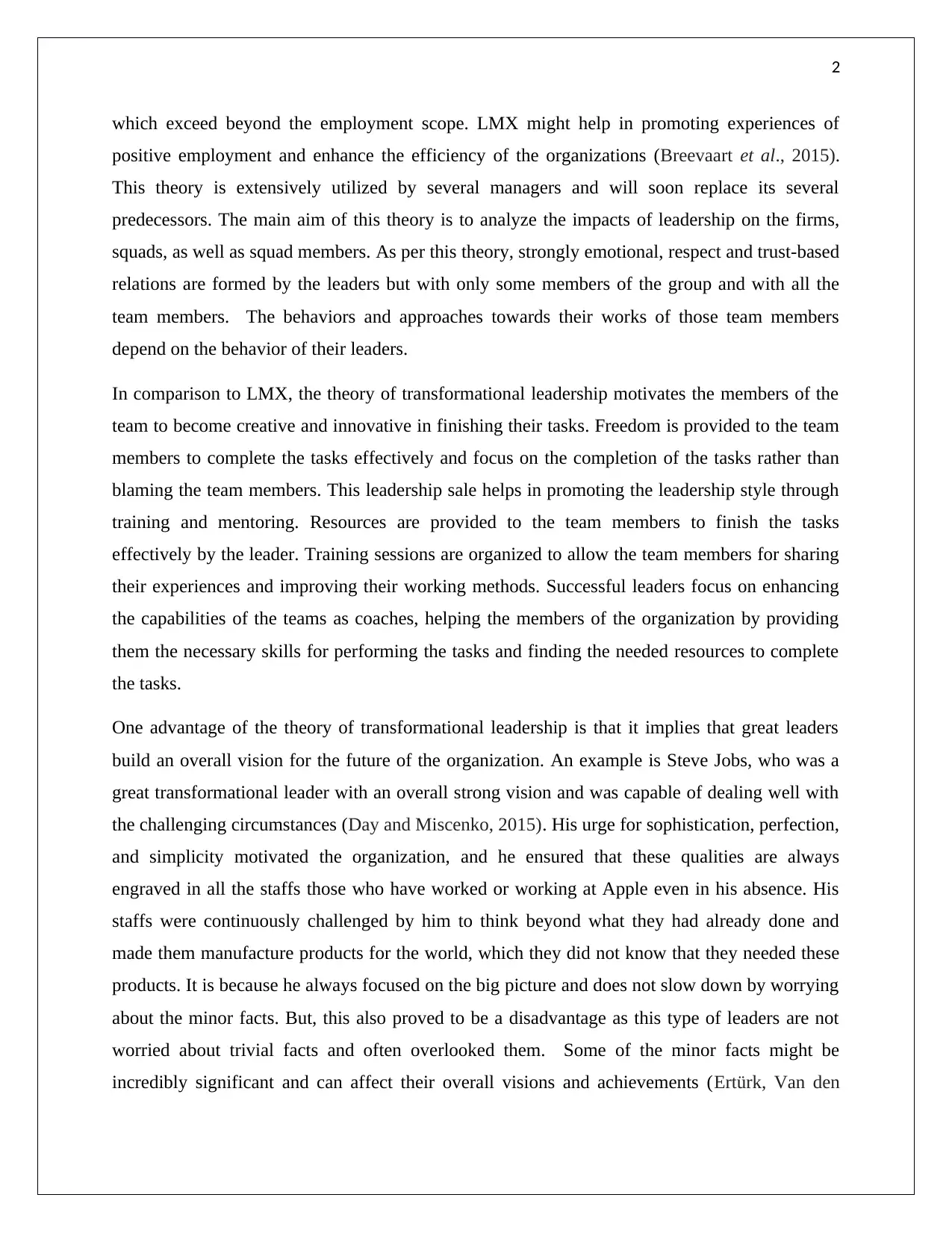
2
which exceed beyond the employment scope. LMX might help in promoting experiences of
positive employment and enhance the efficiency of the organizations (Breevaart et al., 2015).
This theory is extensively utilized by several managers and will soon replace its several
predecessors. The main aim of this theory is to analyze the impacts of leadership on the firms,
squads, as well as squad members. As per this theory, strongly emotional, respect and trust-based
relations are formed by the leaders but with only some members of the group and with all the
team members. The behaviors and approaches towards their works of those team members
depend on the behavior of their leaders.
In comparison to LMX, the theory of transformational leadership motivates the members of the
team to become creative and innovative in finishing their tasks. Freedom is provided to the team
members to complete the tasks effectively and focus on the completion of the tasks rather than
blaming the team members. This leadership sale helps in promoting the leadership style through
training and mentoring. Resources are provided to the team members to finish the tasks
effectively by the leader. Training sessions are organized to allow the team members for sharing
their experiences and improving their working methods. Successful leaders focus on enhancing
the capabilities of the teams as coaches, helping the members of the organization by providing
them the necessary skills for performing the tasks and finding the needed resources to complete
the tasks.
One advantage of the theory of transformational leadership is that it implies that great leaders
build an overall vision for the future of the organization. An example is Steve Jobs, who was a
great transformational leader with an overall strong vision and was capable of dealing well with
the challenging circumstances (Day and Miscenko, 2015). His urge for sophistication, perfection,
and simplicity motivated the organization, and he ensured that these qualities are always
engraved in all the staffs those who have worked or working at Apple even in his absence. His
staffs were continuously challenged by him to think beyond what they had already done and
made them manufacture products for the world, which they did not know that they needed these
products. It is because he always focused on the big picture and does not slow down by worrying
about the minor facts. But, this also proved to be a disadvantage as this type of leaders are not
worried about trivial facts and often overlooked them. Some of the minor facts might be
incredibly significant and can affect their overall visions and achievements (Ertürk, Van den
which exceed beyond the employment scope. LMX might help in promoting experiences of
positive employment and enhance the efficiency of the organizations (Breevaart et al., 2015).
This theory is extensively utilized by several managers and will soon replace its several
predecessors. The main aim of this theory is to analyze the impacts of leadership on the firms,
squads, as well as squad members. As per this theory, strongly emotional, respect and trust-based
relations are formed by the leaders but with only some members of the group and with all the
team members. The behaviors and approaches towards their works of those team members
depend on the behavior of their leaders.
In comparison to LMX, the theory of transformational leadership motivates the members of the
team to become creative and innovative in finishing their tasks. Freedom is provided to the team
members to complete the tasks effectively and focus on the completion of the tasks rather than
blaming the team members. This leadership sale helps in promoting the leadership style through
training and mentoring. Resources are provided to the team members to finish the tasks
effectively by the leader. Training sessions are organized to allow the team members for sharing
their experiences and improving their working methods. Successful leaders focus on enhancing
the capabilities of the teams as coaches, helping the members of the organization by providing
them the necessary skills for performing the tasks and finding the needed resources to complete
the tasks.
One advantage of the theory of transformational leadership is that it implies that great leaders
build an overall vision for the future of the organization. An example is Steve Jobs, who was a
great transformational leader with an overall strong vision and was capable of dealing well with
the challenging circumstances (Day and Miscenko, 2015). His urge for sophistication, perfection,
and simplicity motivated the organization, and he ensured that these qualities are always
engraved in all the staffs those who have worked or working at Apple even in his absence. His
staffs were continuously challenged by him to think beyond what they had already done and
made them manufacture products for the world, which they did not know that they needed these
products. It is because he always focused on the big picture and does not slow down by worrying
about the minor facts. But, this also proved to be a disadvantage as this type of leaders are not
worried about trivial facts and often overlooked them. Some of the minor facts might be
incredibly significant and can affect their overall visions and achievements (Ertürk, Van den
⊘ This is a preview!⊘
Do you want full access?
Subscribe today to unlock all pages.

Trusted by 1+ million students worldwide
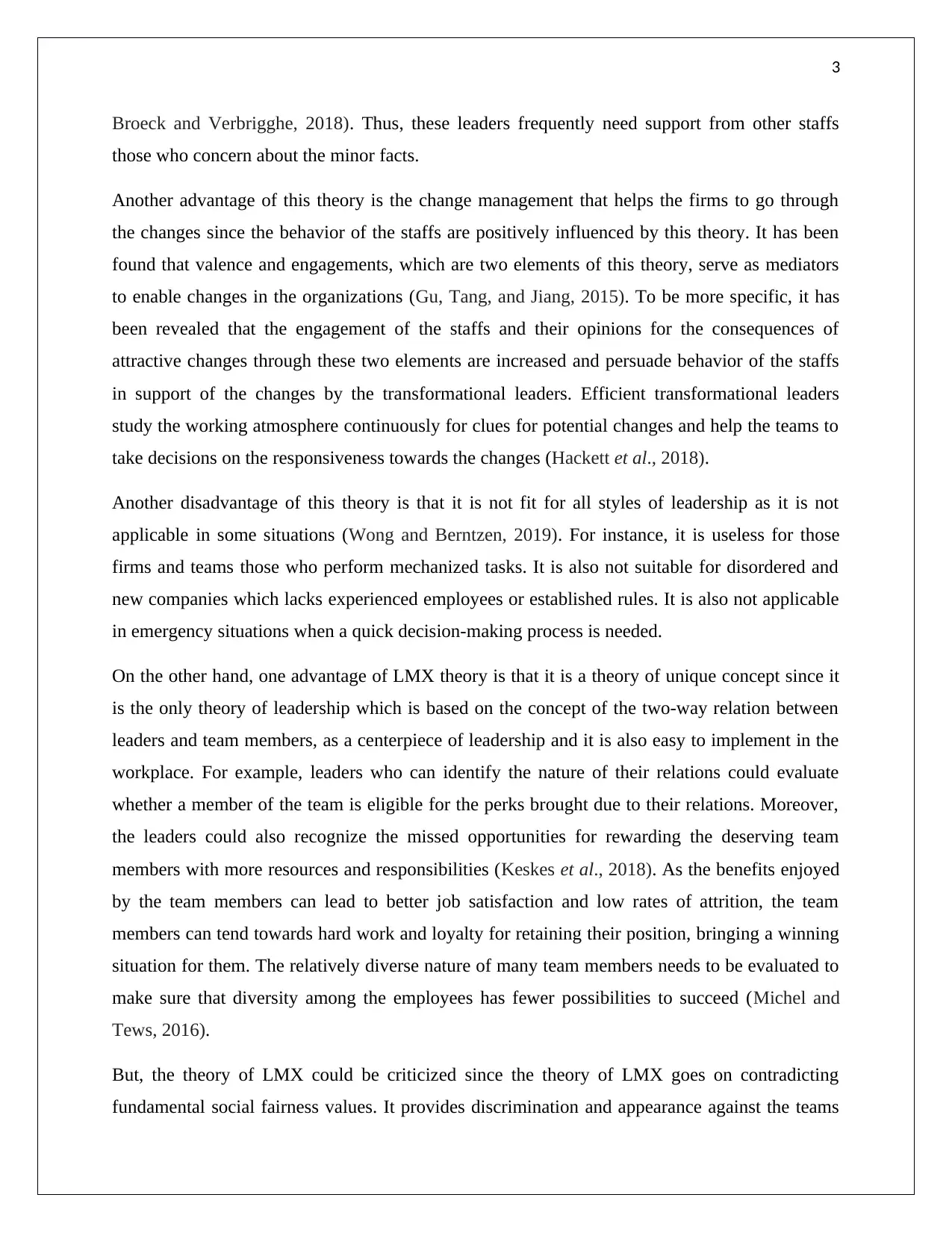
3
Broeck and Verbrigghe, 2018). Thus, these leaders frequently need support from other staffs
those who concern about the minor facts.
Another advantage of this theory is the change management that helps the firms to go through
the changes since the behavior of the staffs are positively influenced by this theory. It has been
found that valence and engagements, which are two elements of this theory, serve as mediators
to enable changes in the organizations (Gu, Tang, and Jiang, 2015). To be more specific, it has
been revealed that the engagement of the staffs and their opinions for the consequences of
attractive changes through these two elements are increased and persuade behavior of the staffs
in support of the changes by the transformational leaders. Efficient transformational leaders
study the working atmosphere continuously for clues for potential changes and help the teams to
take decisions on the responsiveness towards the changes (Hackett et al., 2018).
Another disadvantage of this theory is that it is not fit for all styles of leadership as it is not
applicable in some situations (Wong and Berntzen, 2019). For instance, it is useless for those
firms and teams those who perform mechanized tasks. It is also not suitable for disordered and
new companies which lacks experienced employees or established rules. It is also not applicable
in emergency situations when a quick decision-making process is needed.
On the other hand, one advantage of LMX theory is that it is a theory of unique concept since it
is the only theory of leadership which is based on the concept of the two-way relation between
leaders and team members, as a centerpiece of leadership and it is also easy to implement in the
workplace. For example, leaders who can identify the nature of their relations could evaluate
whether a member of the team is eligible for the perks brought due to their relations. Moreover,
the leaders could also recognize the missed opportunities for rewarding the deserving team
members with more resources and responsibilities (Keskes et al., 2018). As the benefits enjoyed
by the team members can lead to better job satisfaction and low rates of attrition, the team
members can tend towards hard work and loyalty for retaining their position, bringing a winning
situation for them. The relatively diverse nature of many team members needs to be evaluated to
make sure that diversity among the employees has fewer possibilities to succeed (Michel and
Tews, 2016).
But, the theory of LMX could be criticized since the theory of LMX goes on contradicting
fundamental social fairness values. It provides discrimination and appearance against the teams
Broeck and Verbrigghe, 2018). Thus, these leaders frequently need support from other staffs
those who concern about the minor facts.
Another advantage of this theory is the change management that helps the firms to go through
the changes since the behavior of the staffs are positively influenced by this theory. It has been
found that valence and engagements, which are two elements of this theory, serve as mediators
to enable changes in the organizations (Gu, Tang, and Jiang, 2015). To be more specific, it has
been revealed that the engagement of the staffs and their opinions for the consequences of
attractive changes through these two elements are increased and persuade behavior of the staffs
in support of the changes by the transformational leaders. Efficient transformational leaders
study the working atmosphere continuously for clues for potential changes and help the teams to
take decisions on the responsiveness towards the changes (Hackett et al., 2018).
Another disadvantage of this theory is that it is not fit for all styles of leadership as it is not
applicable in some situations (Wong and Berntzen, 2019). For instance, it is useless for those
firms and teams those who perform mechanized tasks. It is also not suitable for disordered and
new companies which lacks experienced employees or established rules. It is also not applicable
in emergency situations when a quick decision-making process is needed.
On the other hand, one advantage of LMX theory is that it is a theory of unique concept since it
is the only theory of leadership which is based on the concept of the two-way relation between
leaders and team members, as a centerpiece of leadership and it is also easy to implement in the
workplace. For example, leaders who can identify the nature of their relations could evaluate
whether a member of the team is eligible for the perks brought due to their relations. Moreover,
the leaders could also recognize the missed opportunities for rewarding the deserving team
members with more resources and responsibilities (Keskes et al., 2018). As the benefits enjoyed
by the team members can lead to better job satisfaction and low rates of attrition, the team
members can tend towards hard work and loyalty for retaining their position, bringing a winning
situation for them. The relatively diverse nature of many team members needs to be evaluated to
make sure that diversity among the employees has fewer possibilities to succeed (Michel and
Tews, 2016).
But, the theory of LMX could be criticized since the theory of LMX goes on contradicting
fundamental social fairness values. It provides discrimination and appearance against the teams
Paraphrase This Document
Need a fresh take? Get an instant paraphrase of this document with our AI Paraphraser
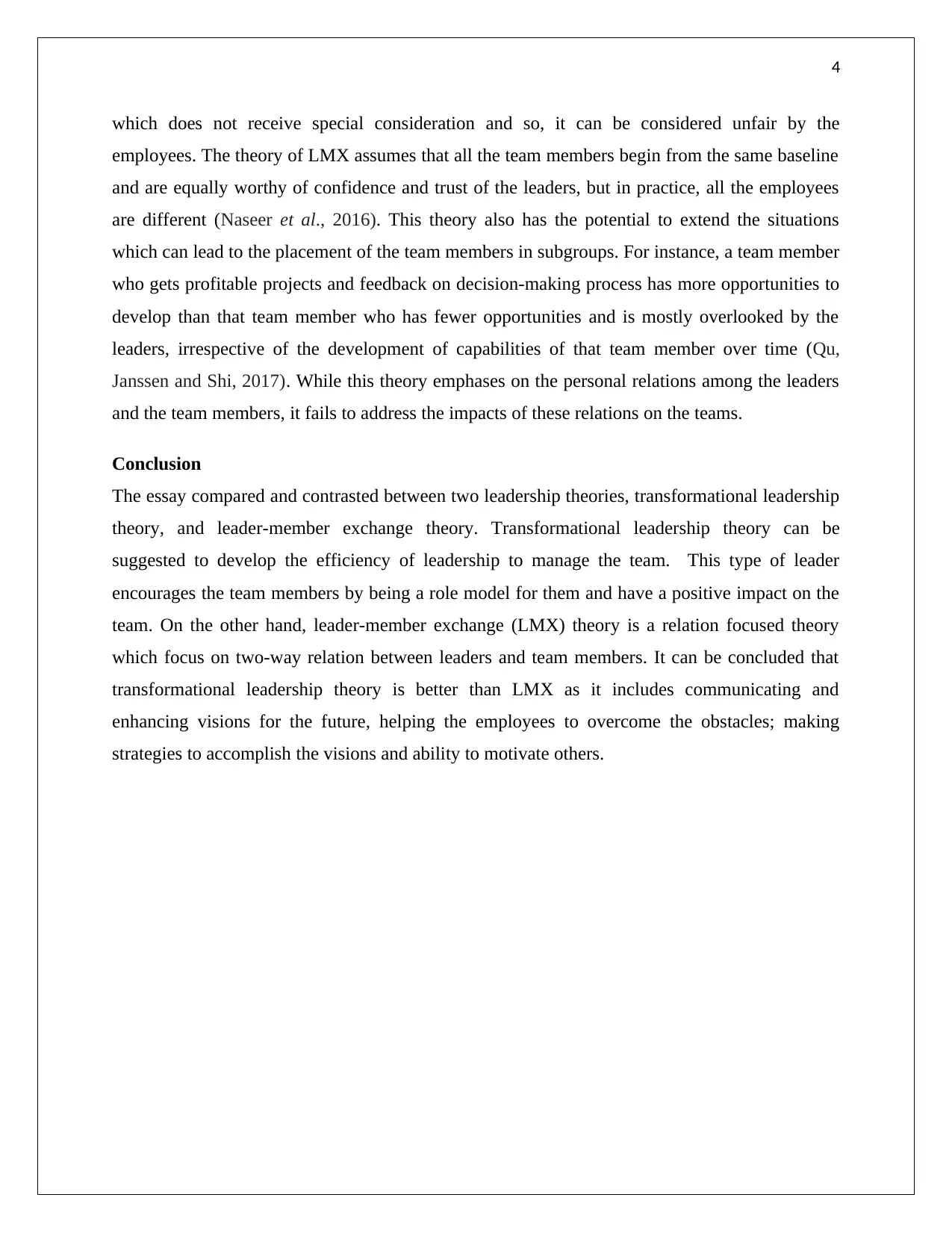
4
which does not receive special consideration and so, it can be considered unfair by the
employees. The theory of LMX assumes that all the team members begin from the same baseline
and are equally worthy of confidence and trust of the leaders, but in practice, all the employees
are different (Naseer et al., 2016). This theory also has the potential to extend the situations
which can lead to the placement of the team members in subgroups. For instance, a team member
who gets profitable projects and feedback on decision-making process has more opportunities to
develop than that team member who has fewer opportunities and is mostly overlooked by the
leaders, irrespective of the development of capabilities of that team member over time (Qu,
Janssen and Shi, 2017). While this theory emphases on the personal relations among the leaders
and the team members, it fails to address the impacts of these relations on the teams.
Conclusion
The essay compared and contrasted between two leadership theories, transformational leadership
theory, and leader-member exchange theory. Transformational leadership theory can be
suggested to develop the efficiency of leadership to manage the team. This type of leader
encourages the team members by being a role model for them and have a positive impact on the
team. On the other hand, leader-member exchange (LMX) theory is a relation focused theory
which focus on two-way relation between leaders and team members. It can be concluded that
transformational leadership theory is better than LMX as it includes communicating and
enhancing visions for the future, helping the employees to overcome the obstacles; making
strategies to accomplish the visions and ability to motivate others.
which does not receive special consideration and so, it can be considered unfair by the
employees. The theory of LMX assumes that all the team members begin from the same baseline
and are equally worthy of confidence and trust of the leaders, but in practice, all the employees
are different (Naseer et al., 2016). This theory also has the potential to extend the situations
which can lead to the placement of the team members in subgroups. For instance, a team member
who gets profitable projects and feedback on decision-making process has more opportunities to
develop than that team member who has fewer opportunities and is mostly overlooked by the
leaders, irrespective of the development of capabilities of that team member over time (Qu,
Janssen and Shi, 2017). While this theory emphases on the personal relations among the leaders
and the team members, it fails to address the impacts of these relations on the teams.
Conclusion
The essay compared and contrasted between two leadership theories, transformational leadership
theory, and leader-member exchange theory. Transformational leadership theory can be
suggested to develop the efficiency of leadership to manage the team. This type of leader
encourages the team members by being a role model for them and have a positive impact on the
team. On the other hand, leader-member exchange (LMX) theory is a relation focused theory
which focus on two-way relation between leaders and team members. It can be concluded that
transformational leadership theory is better than LMX as it includes communicating and
enhancing visions for the future, helping the employees to overcome the obstacles; making
strategies to accomplish the visions and ability to motivate others.
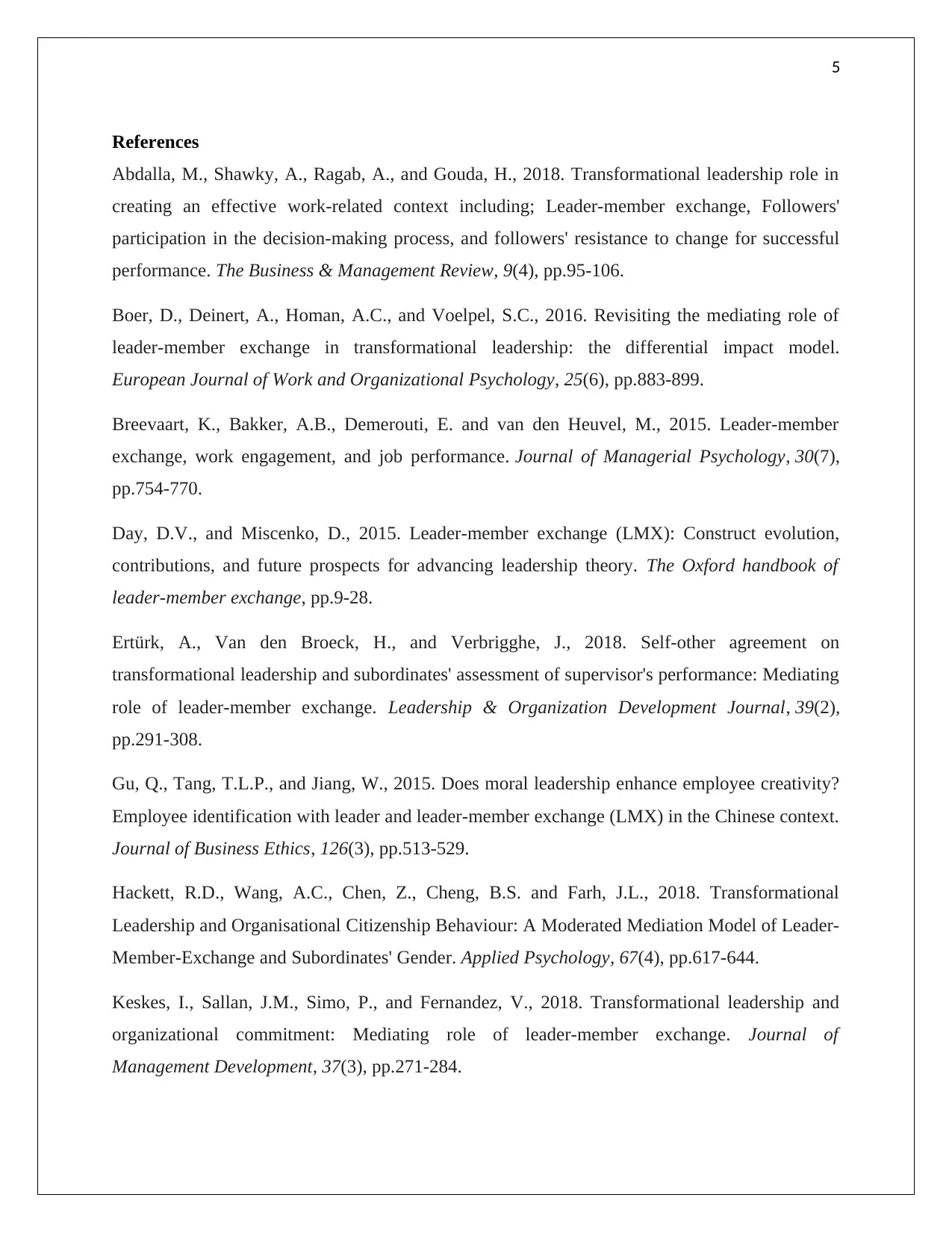
5
References
Abdalla, M., Shawky, A., Ragab, A., and Gouda, H., 2018. Transformational leadership role in
creating an effective work-related context including; Leader-member exchange, Followers'
participation in the decision-making process, and followers' resistance to change for successful
performance. The Business & Management Review, 9(4), pp.95-106.
Boer, D., Deinert, A., Homan, A.C., and Voelpel, S.C., 2016. Revisiting the mediating role of
leader-member exchange in transformational leadership: the differential impact model.
European Journal of Work and Organizational Psychology, 25(6), pp.883-899.
Breevaart, K., Bakker, A.B., Demerouti, E. and van den Heuvel, M., 2015. Leader-member
exchange, work engagement, and job performance. Journal of Managerial Psychology, 30(7),
pp.754-770.
Day, D.V., and Miscenko, D., 2015. Leader-member exchange (LMX): Construct evolution,
contributions, and future prospects for advancing leadership theory. The Oxford handbook of
leader-member exchange, pp.9-28.
Ertürk, A., Van den Broeck, H., and Verbrigghe, J., 2018. Self-other agreement on
transformational leadership and subordinates' assessment of supervisor's performance: Mediating
role of leader-member exchange. Leadership & Organization Development Journal, 39(2),
pp.291-308.
Gu, Q., Tang, T.L.P., and Jiang, W., 2015. Does moral leadership enhance employee creativity?
Employee identification with leader and leader-member exchange (LMX) in the Chinese context.
Journal of Business Ethics, 126(3), pp.513-529.
Hackett, R.D., Wang, A.C., Chen, Z., Cheng, B.S. and Farh, J.L., 2018. Transformational
Leadership and Organisational Citizenship Behaviour: A Moderated Mediation Model of Leader‐
Member‐Exchange and Subordinates' Gender. Applied Psychology, 67(4), pp.617-644.
Keskes, I., Sallan, J.M., Simo, P., and Fernandez, V., 2018. Transformational leadership and
organizational commitment: Mediating role of leader-member exchange. Journal of
Management Development, 37(3), pp.271-284.
References
Abdalla, M., Shawky, A., Ragab, A., and Gouda, H., 2018. Transformational leadership role in
creating an effective work-related context including; Leader-member exchange, Followers'
participation in the decision-making process, and followers' resistance to change for successful
performance. The Business & Management Review, 9(4), pp.95-106.
Boer, D., Deinert, A., Homan, A.C., and Voelpel, S.C., 2016. Revisiting the mediating role of
leader-member exchange in transformational leadership: the differential impact model.
European Journal of Work and Organizational Psychology, 25(6), pp.883-899.
Breevaart, K., Bakker, A.B., Demerouti, E. and van den Heuvel, M., 2015. Leader-member
exchange, work engagement, and job performance. Journal of Managerial Psychology, 30(7),
pp.754-770.
Day, D.V., and Miscenko, D., 2015. Leader-member exchange (LMX): Construct evolution,
contributions, and future prospects for advancing leadership theory. The Oxford handbook of
leader-member exchange, pp.9-28.
Ertürk, A., Van den Broeck, H., and Verbrigghe, J., 2018. Self-other agreement on
transformational leadership and subordinates' assessment of supervisor's performance: Mediating
role of leader-member exchange. Leadership & Organization Development Journal, 39(2),
pp.291-308.
Gu, Q., Tang, T.L.P., and Jiang, W., 2015. Does moral leadership enhance employee creativity?
Employee identification with leader and leader-member exchange (LMX) in the Chinese context.
Journal of Business Ethics, 126(3), pp.513-529.
Hackett, R.D., Wang, A.C., Chen, Z., Cheng, B.S. and Farh, J.L., 2018. Transformational
Leadership and Organisational Citizenship Behaviour: A Moderated Mediation Model of Leader‐
Member‐Exchange and Subordinates' Gender. Applied Psychology, 67(4), pp.617-644.
Keskes, I., Sallan, J.M., Simo, P., and Fernandez, V., 2018. Transformational leadership and
organizational commitment: Mediating role of leader-member exchange. Journal of
Management Development, 37(3), pp.271-284.
⊘ This is a preview!⊘
Do you want full access?
Subscribe today to unlock all pages.

Trusted by 1+ million students worldwide
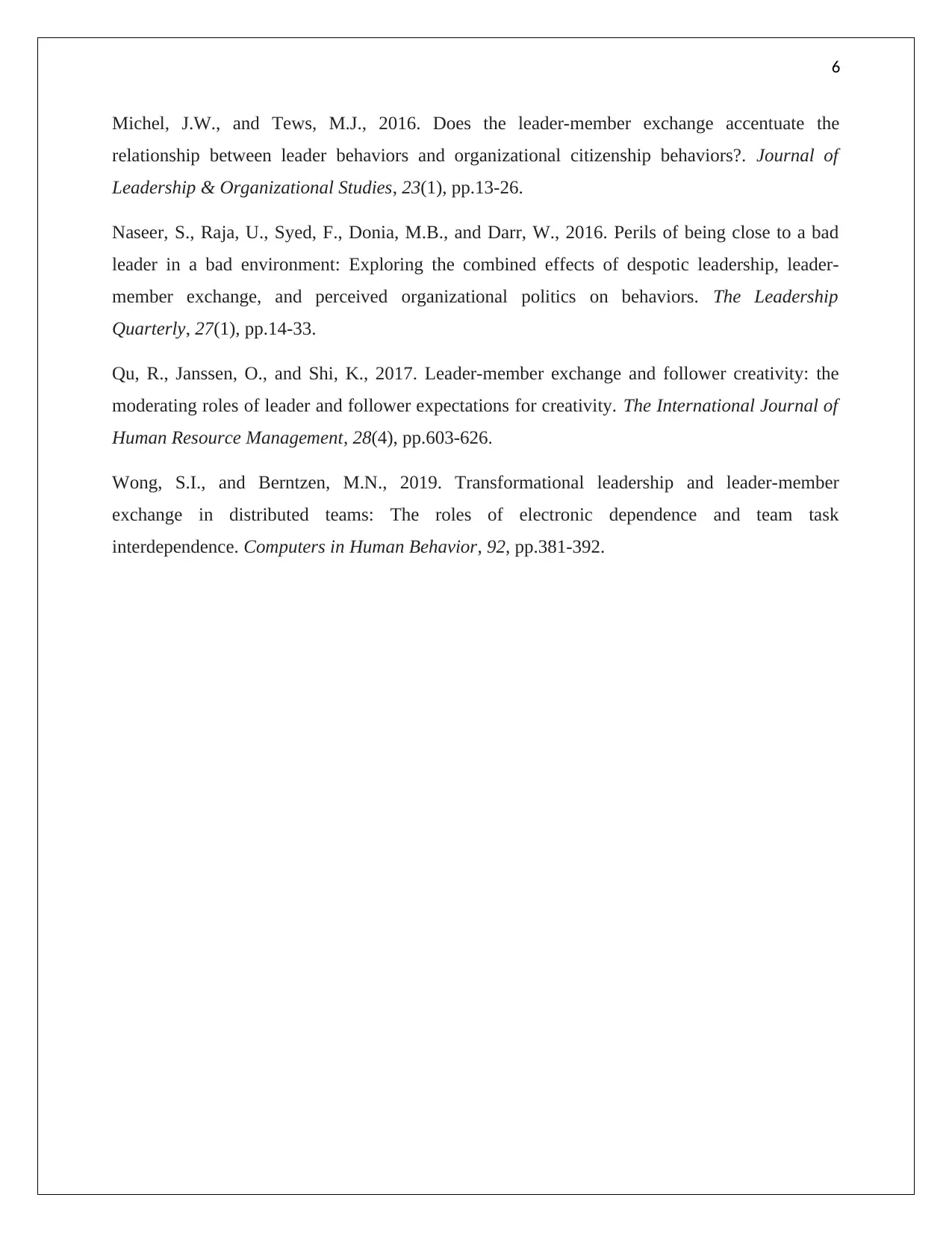
6
Michel, J.W., and Tews, M.J., 2016. Does the leader-member exchange accentuate the
relationship between leader behaviors and organizational citizenship behaviors?. Journal of
Leadership & Organizational Studies, 23(1), pp.13-26.
Naseer, S., Raja, U., Syed, F., Donia, M.B., and Darr, W., 2016. Perils of being close to a bad
leader in a bad environment: Exploring the combined effects of despotic leadership, leader-
member exchange, and perceived organizational politics on behaviors. The Leadership
Quarterly, 27(1), pp.14-33.
Qu, R., Janssen, O., and Shi, K., 2017. Leader-member exchange and follower creativity: the
moderating roles of leader and follower expectations for creativity. The International Journal of
Human Resource Management, 28(4), pp.603-626.
Wong, S.I., and Berntzen, M.N., 2019. Transformational leadership and leader-member
exchange in distributed teams: The roles of electronic dependence and team task
interdependence. Computers in Human Behavior, 92, pp.381-392.
Michel, J.W., and Tews, M.J., 2016. Does the leader-member exchange accentuate the
relationship between leader behaviors and organizational citizenship behaviors?. Journal of
Leadership & Organizational Studies, 23(1), pp.13-26.
Naseer, S., Raja, U., Syed, F., Donia, M.B., and Darr, W., 2016. Perils of being close to a bad
leader in a bad environment: Exploring the combined effects of despotic leadership, leader-
member exchange, and perceived organizational politics on behaviors. The Leadership
Quarterly, 27(1), pp.14-33.
Qu, R., Janssen, O., and Shi, K., 2017. Leader-member exchange and follower creativity: the
moderating roles of leader and follower expectations for creativity. The International Journal of
Human Resource Management, 28(4), pp.603-626.
Wong, S.I., and Berntzen, M.N., 2019. Transformational leadership and leader-member
exchange in distributed teams: The roles of electronic dependence and team task
interdependence. Computers in Human Behavior, 92, pp.381-392.
1 out of 7
Related Documents
Your All-in-One AI-Powered Toolkit for Academic Success.
+13062052269
info@desklib.com
Available 24*7 on WhatsApp / Email
![[object Object]](/_next/static/media/star-bottom.7253800d.svg)
Unlock your academic potential
Copyright © 2020–2025 A2Z Services. All Rights Reserved. Developed and managed by ZUCOL.





